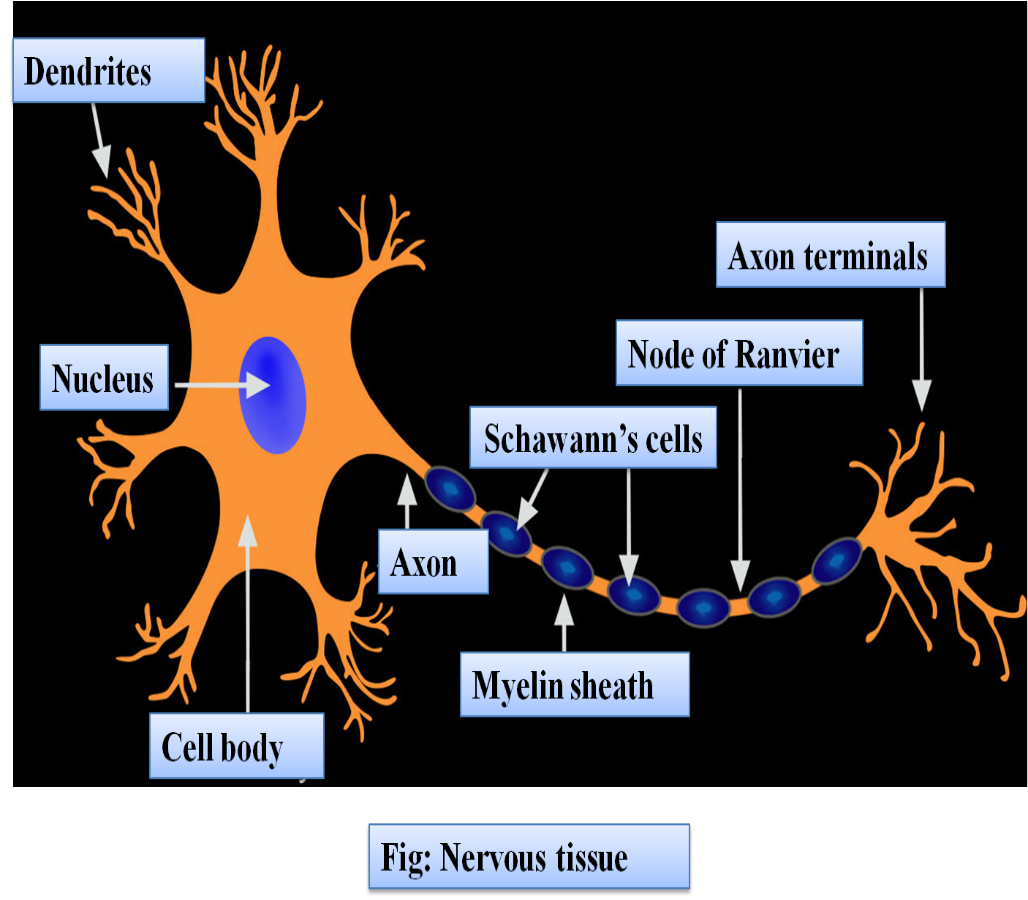
A long fiber-like process coming out of the cyton of a nerve cell is
(a)Axon
(b)Dendron
(c)Neurolemma
(d)Neurofibrils
Answer
505.2k+ views
Hint: They Conduct impulses far away from the cell body. They're in effect the first transmission lines of the nervous system, and as bundles, they assist in composing nerves.
Complete answer:
The nervous system consists of special cells called nerve cells or neurons. Cyton is the main cell body which provides many processes called dendrites. A long fiber-like process coming out of the cyton of a nerve cell is named the axon of the nerve fiber. An axon is an extended, slender projection of a neuron, or neuron, in vertebrates, that typically conducts electrical impulses referred to as action potentials far away from the neuron body. The function of the axon is to carry information to different neurons, muscles, and glands.
Additional Information: -Axon is the functional part of the neuron therefore the term nerve fiber usually asks for an axon. -Axon is roofed by a layer of phospholipids (sphingomyelin) which is named as medulla or myelin sheath.
-Dendrons are short, branched parts begin from the cell body (cyton). Dendrons are many in number.
-Neurolemma is the outermost nucleated cytoplasmic layer of Schwann cells. It surrounds the axon of the neuron.
-Neurofibrils are long, thin, microscopic fibrils that move in all directions within the cell body and also extend in axons and dendrites.

So, the correct answer is ‘Axon’.
Note: -The longest axons within the physical body are those of the sciatic nerve, which run from the bottom of the spinal cord to the large toe of every foot. The diameter of axons is additionally variable. Most individual axons are microscopic in diameter, generally about one micrometer. The largest mammalian axon is a diameter of up to 20 µm.
-The neuron is the main component of nerve tissue altogether animals except for sponges and placozoa. Plants and fungi don't have nerve cells.
Complete answer:
The nervous system consists of special cells called nerve cells or neurons. Cyton is the main cell body which provides many processes called dendrites. A long fiber-like process coming out of the cyton of a nerve cell is named the axon of the nerve fiber. An axon is an extended, slender projection of a neuron, or neuron, in vertebrates, that typically conducts electrical impulses referred to as action potentials far away from the neuron body. The function of the axon is to carry information to different neurons, muscles, and glands.
Additional Information: -Axon is the functional part of the neuron therefore the term nerve fiber usually asks for an axon. -Axon is roofed by a layer of phospholipids (sphingomyelin) which is named as medulla or myelin sheath.
-Dendrons are short, branched parts begin from the cell body (cyton). Dendrons are many in number.
-Neurolemma is the outermost nucleated cytoplasmic layer of Schwann cells. It surrounds the axon of the neuron.
-Neurofibrils are long, thin, microscopic fibrils that move in all directions within the cell body and also extend in axons and dendrites.

So, the correct answer is ‘Axon’.
Note: -The longest axons within the physical body are those of the sciatic nerve, which run from the bottom of the spinal cord to the large toe of every foot. The diameter of axons is additionally variable. Most individual axons are microscopic in diameter, generally about one micrometer. The largest mammalian axon is a diameter of up to 20 µm.
-The neuron is the main component of nerve tissue altogether animals except for sponges and placozoa. Plants and fungi don't have nerve cells.
Recently Updated Pages
Master Class 11 Business Studies: Engaging Questions & Answers for Success

Master Class 11 Accountancy: Engaging Questions & Answers for Success

Master Class 11 Computer Science: Engaging Questions & Answers for Success

Master Class 11 English: Engaging Questions & Answers for Success

Master Class 11 Social Science: Engaging Questions & Answers for Success

Master Class 11 Economics: Engaging Questions & Answers for Success

Trending doubts
Which one is a true fish A Jellyfish B Starfish C Dogfish class 11 biology CBSE

State and prove Bernoullis theorem class 11 physics CBSE

1 ton equals to A 100 kg B 1000 kg C 10 kg D 10000 class 11 physics CBSE

In which part of the body the blood is purified oxygenation class 11 biology CBSE

One Metric ton is equal to kg A 10000 B 1000 C 100 class 11 physics CBSE

Difference Between Prokaryotic Cells and Eukaryotic Cells




